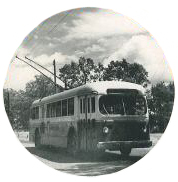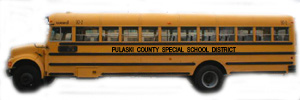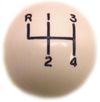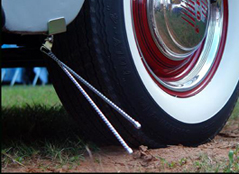We Went Places
“Where the hell was Biddle Shops
and what the hell was Tie Plant?"
(Sung to the tune of "I've Been Everywhere")
Raymond Merritt, 2008
In Little Rock, everybody rode the streetcar, AKA trolley.
You can see a real one
HERE.
 It's all beat up on the side because they often scraped parked cars that
stuck out into the roadway.
Technically, the streetcar
was the vehicle and the trolley was the doodad on the roof of the streetcar
that connected to the overhead electric lines, but everyone used both terms
for the vehicle. Until 1947, streetcars ran on
rails down the middle of the street. (The last rail cars ran Christmas day, 1947.)
Then the rails were paved over and rubber-tired
busses replaced the rail cars. They still used the overhead
electric lines and though officially they were trolleybusses
we still called them streetcars or just trolleys.
They had the advantage of being able to pick up passengers at the curb
so were much safer because it was common for someone getting off of a rail car to be
struck by an automobile passing on the right.
It's all beat up on the side because they often scraped parked cars that
stuck out into the roadway.
Technically, the streetcar
was the vehicle and the trolley was the doodad on the roof of the streetcar
that connected to the overhead electric lines, but everyone used both terms
for the vehicle. Until 1947, streetcars ran on
rails down the middle of the street. (The last rail cars ran Christmas day, 1947.)
Then the rails were paved over and rubber-tired
busses replaced the rail cars. They still used the overhead
electric lines and though officially they were trolleybusses
we still called them streetcars or just trolleys.
They had the advantage of being able to pick up passengers at the curb
so were much safer because it was common for someone getting off of a rail car to be
struck by an automobile passing on the right.
The streetcar line route map is HERE. Note on the map that PRW means "Private Right Of Way". Jonesboro Drive, which goes north into Fair Park from 12th street, has always been two lanes, but one of those lanes was once named Monroe St. and was reserved only for trolleys, as was Kavanaugh hill -- Kavanaugh Blvd. from about North Lookout to about Cantrell. Although the map shows the streetcar line ending at Hayes St., it actually went further. At the intersection of Kavanaugh, North McKinley, and Pine Valley Roads, where Pine Valley Road starts northwest to Cammack Village, there was a big circle. This was the terminus for the line where the streetcars or trolleybusses made a 360 and headed back to downtown. By the mid-1950s all busses were diesel, so they could travel beyond this circle and serve the new Kingwood Addition, located down Pine Valley and beyond Cammack Village.
Prior to 1952, the streetcar line was the Capitol Transportation Company, or CTC, then from 1952 until 1956 it was the Capitol Transit Company. Then in July, 1955, a lengthy transit strike began which got nasty, including shots taken at busses and busses rammed by cars. In one incident (August 1, 1955) three men were arrested after a gun battle in the Capitol Transit bus parking lot, and in another (On November 15, 1955) a bus was dynamited at 29th and Battery. The transit worker's union swore they had nothing to do with any of the violence. At any rate, CTC went belly up, surrendering its franchises to city fathers in January, 1956. It was reincarnated on Valentine's day, 1956, as the Citizen's Coach Company and remained so until 1962 when it began a 10-year run as Twin City Transit Company. Today it's Central Arkansas Transit (Authority), or CAT.
To ride the streetcar you could use coins or tokens or a transfer from another streetcar. You put the coins or tokens in a Johnson Fare Box exactly like the one HERE. If you gave the driver a dollar, he gave you change, and then you dropped the correct fare into the fare box. You could ride anywhere for single fare, but only one way. To get back home you had to pay another fare. If your route required you to change to another streetcar, you asked the driver for a transfer and he gave you a little slip of colored paper. Each route had a different color. If you got on a streetcar and used a transfer, it had to be a different color than the one for the route you were trying to board. That kept you from using a transfer as a round-trip ticket. Today, transit companies charge extra for transfers. You can see some tokens and transfers by clicking HERE.
A favorite diversion was pulling the trolley off of the electric lines at the rear of the streetcars. It was a big deal to us, but I never realized until many years later that it wasn’t a big deal to the drivers. In fact, the trolleys frequently jumped off of the wires by themselves.
Students in the city walked to school or rode the streetcar. Soccer moms didn't exist because few families owned two cars and dad used the family car to go to work. To get on the streetcar you could use tokens, and students got discounted tokens. If you lived a long way from school you might have had to transfer to another streetcar to get to your school. You can see some tokens and transfers by clicking HERE.

Students in rural areas rode yellow school busses manufactured by Ward School Bus Company in Conway, Arkansas. Ward wasn't fly-by-night, either. Around 1967, Ward voluntarily subjected one of their school busses to multiple rollovers and published their findings, noting the separation at the joints, and pointing out that many of their competitors were using far fewer rivets. This resulted in new attention by all the school bus companies to the quality of construction techniques. By the way, school busses have been yellow since the color was adopted as a standard in 1939, not to make it easier to see the bus, but to make it easier to read the black lettering on the side in the dim early morning light. In many areas several busses passed your stop and you had to be sure you got on the right one.

 Four Words: Four On The Floor. That was our goal. To our parents, who grew up
driving cars with three speed transmissions and shift levers on the steering column,
automatic transmissions were a luxury and that was what they opted for. But for us,
A four speed transmission with a floor shifter, preferably a Hurst, was the ultimate
cool. I finally got mine in 1965 (a GTO) but by then it really didn't matter. Few
kids today can drive a standard shift of any kind -- most have never seen one. Even
my Craftsman lawn tractor has an automatic transmission.
Four Words: Four On The Floor. That was our goal. To our parents, who grew up
driving cars with three speed transmissions and shift levers on the steering column,
automatic transmissions were a luxury and that was what they opted for. But for us,
A four speed transmission with a floor shifter, preferably a Hurst, was the ultimate
cool. I finally got mine in 1965 (a GTO) but by then it really didn't matter. Few
kids today can drive a standard shift of any kind -- most have never seen one. Even
my Craftsman lawn tractor has an automatic transmission.
DX Service station at Asher & University. I worked there in the summer of ‘59. Harry Pranger owned it at first, then sold it to Pete Clowers. Pete also owned a Gulf station in Park Hill and drove a Cadillac. You could make a good living if you owned a service station. Most guys worked at a service station at one time. Know why there were so many service station jobs? Because they were service stations. You got your windshield cleaned, oil checked, gas pumped, and tires checked, all without asking, all for free, by some kid like me.

Curb Feelers. Attached to the fenders of your car, they were invaluable when trying
to parallel park a car along a city street. The law required that the wheels of your
car be within 12 inches of the curb, but if you scraped the curb you could really
mess up the whitewalls. Curb feelers let you park perfectly.
Malls and their big parking lots, and blackwall tires, made curb
feelers unnecessary, so now they're an oddity.
The vast majority of cars had white sidewall tires, and most tire dealers did not even bother to stock black sidewall tires. But white sidewalls cost more than black sidewalls, so a few people, especially teenagers, were forced to buy black sidewall tires to save money. But if you wanted black sidewall tires and the tire dealer didn't have any in stock, they sold you white sidewall tires at the black sidewall price and mounted the tires with the white sidewall facing inward. So when I bought tires, I looked at their inventory to make sure they didn't have any black sidewall tires in stock, then when I got home I took the white sidewalls off, turned them around, and remounted them. Wallah, white sidewall tires for the price of blackwalls. In the 1944 movie "Murder, My Sweet", which starred Dick Powell (From Mountain View, Arkansas) there is a parking garage scene in which several cars have blackwall tires, but if you watch them as the cast walks past them you will plainly see that the tires are whitewalls with the whitewalls turned inward.

